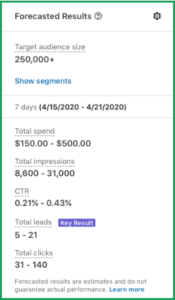How to turn uncertainty into opportunity with paid media

A consistent trait of successful businesses is their ability to adapt, and transform restraints into slingshots for growth. Don’t take our word for it. Hustle actually did a survey of more than 200 businesses that have recently survived a time of great uncertainty – the market crash of 2009. Turns out, around 60% of these survivor companies went on the offensive with their marketing efforts. Top two of the winning strategies adopted by them included ‘optimizing spending’, and ‘pivoting’. The key takeaway from this recent history is that uncertainty can be an asset with the right digital marketing strategy. We decided to put this to test.
As a B2B business, that predominantly markets to businesses, we used our own ad campaign as a case study. The result? We achieved a CPL 76% lower than the industry benchmark with multi-variant testing, flexible flight time, and decreased PPC competitiveness. Read on to know what made our marketing experiment successful.
Why we chose to test LinkedIn ROI
B2B businesses usually have mixed feelings about LinkedIn, they love the laser-accurate targeting capacity and the professional nature of the network but fear the higher media spend compared to other PPC platforms. When operating on a smaller marketing budget, the cons of LinkedIn tend to get accentuated, and more noticeable.
After all, it’s difficult to ignore the lack of account promotion support, or very basic ad targeting platform in addition to the complex nature of campaign management on LinkedIn. In fact, the platform doesn’t offer functions that we take for granted such as bulk editing.
Does it mean it’s not worth advertising on LinkedIn at all? Of course not, it remains as the most serious targeting universe, and countless industry experts still swear by it. Do check out our little easter egg at the end of this post for useful links that highlight the positives. While we weighed the pros and cons ourselves, the distinct lack of data to support either was quite obvious. This helped us zero in on LinkedIn as our choice of platform.
Another very good reason was our hypothesis about the correlation between competitiveness and lower CPL. Amid the pandemic, we witnessed many non-essential businesses shift their marketing focus away from paid media, but it makes us wonder, does this reduced competitiveness lead to a lower CPL/higher ROAS for businesses who dare to rock on with their marketing effort? Our test campaign was aimed at finding an answer to this question while also generating leads for our own marketing team.

Campaign setup and measurements method
We launched an ebook download lead generation campaign with our best practices during the second week of the pandemic outbreak. The end result of the campaign was a 76% lower CPL than the platform average and outperforming the projections with lead volume. Here are some insights into how we achieved this.
Prior to the campaign setup, we did a projection on performance. Here is what the performance projection with the targeting audience (or more commonly known as buyer’s persona) looks like:

- With a 7-day experiment window, we expected to have 5 – 21 leads gathered through this lead gen campaign. As always, we first aligned this expectation with the client (i.e. ourselves), then proceeded to the ad copy and creative production.
- Opting for a data-driven and test-oriented approach, we composed 3 ads to run simultaneously in a multi-variant testing environment. By the 3rd day, we had already gathered the evidence that one piece of ad copy is significantly under-performing compared to the others based on click-through rate (with confidence level>95%). This copy was immediately sent back to the content team to revise with insights from qualitative research on the search trend.
- On the other hand, since we had a limited budget for this campaign, we wanted to make sure every dollar is spent thoughtfully. We borrowed the platform activity data from our community management team, to identify the best time to post on LinkedIn – 10am on weekdays. So, we decided to only activate the campaign following this best practice and extend the flight time into 7 business days, skipping the weekend
- As a result of our agile ad copy revision, we saw an immediate improvement in click through rate and conversion rate for the once under-performing ad copy, in fact, it has emerged to be the absolute winner among all the ads
Results & possible implication for other platforms
As a result of the regulated flight time, we saw a more stable budget pacing day to day, and controlled the bid each day with updates.
At the end of the campaign we gathered 28 leads over the 7 business days- a whopping 33% higher than projected, with an overall CPL of mere $18
While this marketing experiment offered a tactical solution for one platform, it has opened up a larger discussion on its implications for other platforms. A question worth asking right now is
Is this emerging opportunity applicable to other ppc platforms (cpc trend)?
Some early trends are quite promising. Facebook CPC, for example, has reduced from $ 0.11 in January 2020 to the low of $ 0.9 during March. Google search ad results are more complicated. Although overall conversion seemed to have reduced by 21%, certain industries such as packaging and shipping have seen massive growth in their performance.
Additionally, the impact of various financial aid programs from advertisers as well as the local government is another interesting dimension that needs a closer examination. A combination of various government tax credits such as the one announced by the Quebec Government, supported by corporate initiatives like Google ad credits can encourage many businesses to increase spending. A seemingly counter-intuitive strategy that could be extremely vital to survival.
Conclusion
As a marketing consultancy firm, we are at the forefront of any crisis, a pandemic is no exception. This campaign was our way to tackle the issue using data. The results offered a fresh perspective on testing any new marketing channel, within the larger social context, to identify more cost-effective ways to market ourselves.
What we achieved during the course of this campaign:
- Identifying our LinkedIn CTR benchmark for content-asset based campaigns
- Knowing our baseline CPL
- Benchmark for timelines to launch a fresh campaign ( This one was blazingly fast!)
- New leads to nurture and build partnerships to test the final ROI of the campaign
To sum it up, we have boosted our readiness when the market picks up again while generating enough demand at the same time. Although this campaign was carried out in the midst of much speculation, we realized that this was the perfect opportunity to test and learn. Improvising and making the best of the situation remains one of the key takeaways for BDG from this experience.. Are you thinking of testing any new channels for your business? Let us know in the comments!
Easter egg for marketers – LinkedIn Pro & Cons
Pros:
6 reasons why LinkedIn is the best b2b ad network
5 ways Linkedin advertising is unique
3 big reasons to advertise on LinkedIn
Cons:

